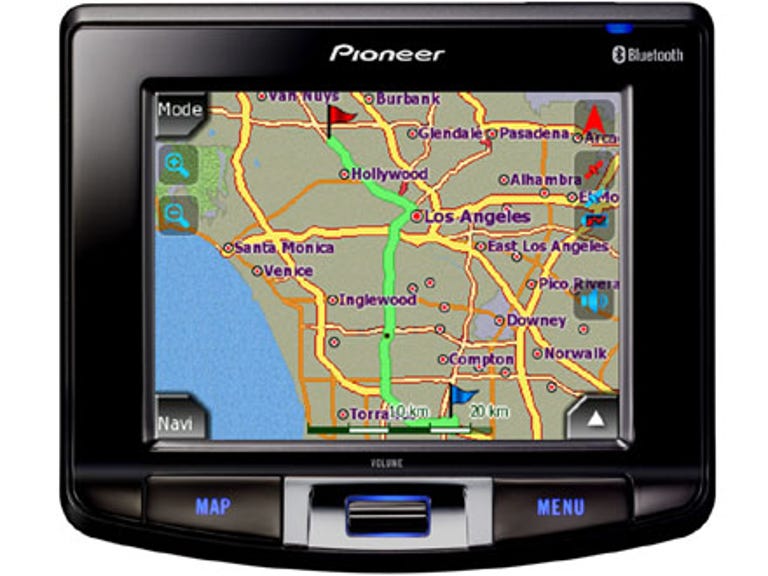 Why You Can Trust CNET
Why You Can Trust CNET Pioneer AVIC-S2 review: Pioneer AVIC-S2
The AVIC-S2 is competent but, aside from Bluetooth, there are similarly specified GPSes for less.
After introducing the world's first GPS in its home market of Japan in 1990, Pioneer took 17 years to dip its toe in our GPS waters. Its two pronged attack aims at both ends of the market. Hoping to make a splash at the high-end is the AU$3,799 AVIC-HD3, which is an integrated double-DIN, GPS, music, video and communications unit. Which leaves the portable AVIC-S2, priced at AU$699, fighting for a slice of the pie at the affordable end of the market.
The Good
The Bad
The Bottom Line
Design
Measuring just 89mm high by 102mm wide and 25mm thick, the S2 is one of the smaller portable GPS units around. Sporting a 3.5-inch touchscreen -- capable of displaying 64,000 colours at a resolution of 320 x 240 -- framed by a clean, matte black border, the S2 looks rather chic. The unit has a rectangular cross-section, meaning it will lie completely flat. Along the right edge is an SD/MMC slot (a 512MB card is included which contains the R14 Whereis maps of Australia), a mini-USB connection and a 3.5mm headphone jack. On top there's a power button which lights up orange when charging and blue when otherwise plugged in.
Turn the device on and it all looks eerily familiar to anyone who used one of Mio's recent models, except for the colour scheme, which is a metallic grey/black to match the Pioneer's exterior. This is not surprising as they both use Nav N Go's software. Like the Mio there's a multitude of information icons on the map screen which double as shortcuts to common settings and functions -- we recommend playing around with the GPS or, heaven forbid, reading the manual before heading off. The only appreciable difference with the Pioneer is that by default, cockpit mode is on, which reduces the map display area to fit a sidebar displaying next turn instructions and other information.
A major gripe we have with the Mio software is that in many screens there's no easy way to return to the navigation map. And when there is an on-screen map button, it's located in different positions. This, in theory, should be solved by the Pioneer's Map and Menu hard buttons, which reside along the neatly curled up bottom lip of the S2. Unfortunately the Map button rarely returns you to the navigation map, rather it cycles between the route information and instruction screens. And the Menu button takes you to the top level menu, not the most commonly used menu screen, where users enter the destination addresses. At least the scroll wheel for adjusting the volume does what you expect.
Features
The S2's two-piece windscreen mount bears an uncanny resemblance to that supplied with the Mio DigiWalker C220 that we recently reviewed. A back plate needs to be attached to the GPS in order to snap it onto the windscreen holder. This set-up makes stashing the S2 away from the prying eyes of would-be thieves a pain, as the GPS is nearly impossible to detach from its windscreen holder. We often ended up hiding the S2 with its holder in our glovebox ... once we had cleared out some space, that is. Uniquely, the Pioneer is shipped with a plate for affixing the holder to your car's dashboard. We weren't game enough to try it, however, for fear of having the plate permanently stuck to our dash by its permanent-looking adhesive bottom.
With its Bluetooth support and built-in microphone, the S2 functions as a mobile hands-free kit. Sound quality was good and we had no problem talking and navigating at the same time. Unfortunately the blue Bluetooth light that flashes when the S2 is paired to a phone is distractingly bright at night. The S2 can also play MP3 files loaded on the SD card but given the rather lacklustre interface we're not sure why you'd bother.
When we tested the S2, no red light or speed camera info was supplied. There's now a free firmware upgrade patch with up-to-date camera info which can be downloaded from the Pioneer Web site. By September 2007, maps for North America and Europe will be available for AU$180.
Performance
Under the skin, the Pioneer does little to stand out from the crowd: it features the near ubiquitous SIRF Star III chipset and comes equipped with an average 64MB of RAM and 256MB of flash ROM.
In day-to-day driving, route calculation times only really ballooned out during cross city treks. It's also best to keep a paper map handy if you frequently need directions within the CBD, as portable GPS devices -- and the Pioneer is no exception -- are easily confused by satellite signals bouncing off buildings. The Pioneer sometimes surprised us with decent routes but in certain circumstances deviating off the prescribed course would lead to a series of instructions asking us to perform illegal u-turns on busy main roads.
So, the experience is little different to the Mio DigiWalker C220. For AU$200 extra, the only upgrades are the headphone jack, microphone, Bluetooth and a more expensive-looking design. Oh, and the Pioneer brand. We're not sure they justify the price difference.


